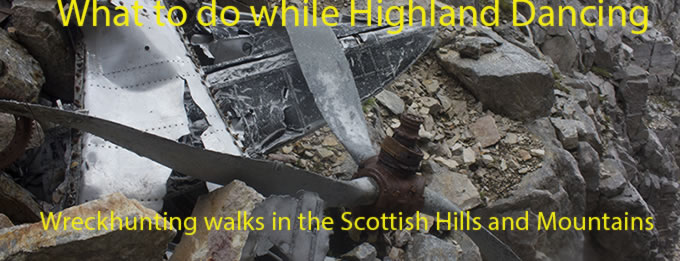Clearances
Vickers Wellington L4348 nr Loch Starthy
I Visited this one over 15 years ago during a week long holiday up the top end of Scotland in my old Abbey Durham Caravan.
I had parked the Caravan at a Caravan Club
campsite beside Loch Navar, at a place called Grummore. Grummore was a
little Village that had suffered from the land clearances which took place
in this Glen in the 18th century, all that remained was the foundations of
all the Buildings, and there was the Caravan Site, although I don't think
that was there in the 18th century!
During the couple of days we were at Grummore my plan was to visit two crashsite, an HP Hampden on Ben Loyal and a Vickers Wellington near Loch Strathy.
Heather and Natalie at Grummore Caravan site near Altnaharra.
As Scotland's Right to Roam act had not yet been introduced and both crashsites were on private Stalking Land I attempted to obtain permission from the Landowners to cross their land. With the help of the Caravan Site Warden, I was successful in gaining clearance to visit the Hampden site but not the Wellington.
View south from where I parked the car.
The Warden did manage to find out that there was no planned stalking on the day I was visiting and suggested I approached from the south instead of the west as I was planning, doing this would avoid any Estate Buildings and Farms, so I should be able to sneak in and out without being noticed.
With the ever increasing cost of fuel nowadays I wish I still had
my old Montego diesel, 70+ mpg on a run and a bulletproof 2.0L perkins
diesel engine that would have gone on forever, unfortunatley the rest of
the car was rather too fond of a bit of rust!

Approaching the Wellington crashsite, the water filled crater is just visible.

Almost at the crater.
 Crankshaft from one of the shattered engines, lying next to one of the cylinder heads.
Crankshaft from one of the shattered engines, lying next to one of the cylinder heads.
Navigating to this crashsite was very easy as I just made for the ridge made up of Cnoc Bothan Uisge-beatha, Creagan Dubha Reidhe Bhig and Meall Ceann Loch Strathy, walked along the top to the northern most end then sat down on a rock overlooking the moorland to the north, then searched for the crashsite with my Binoculars. Walking along the top of the ridge also offered me an uninterrupted view across the moorland for miles in every direction which meant if there should be any Stalkers or Gamekeepers in the vicinity I would easily be able to spot them and scarper. As it transpired I never saw another soul all day.

More Cylinder heads from the smashed engines.
I couldn't see any wreckage from the top of Meall Ceann Loch Strathy but I could make out what looked like a small pool of water, so as this was the only discernable feature on the barren moor and as it was roughly where I had the crashsite marked on my map; I headed towards it.


Once down off the ridge I could no longer see the water but as I approached the area I could see something sticking up above the heather which turned out to be a 6ft long piece of wingspar someone had stood upright in the mud next to the water filled crater. It was clear to see from the shape of the crater how the Wellington had hit the ground as there was a circular shaped area in the middle where the fuselage hit with two narrower and shallower scars emanating from each side where the wings hit. The crater was full of wreckage and there was also a lot collected around the edges most likely trawled out of the water by visitors.

Someone must have stuck the wingspar into
the ground to make the crashsite easier to find.

The circular crater made by the fuselage taken from one of the narrower scars
made by the wings.

above and next 12 photos:-Wreckage of L4348 lying in and around the water filled crater.
 Loch Feusaige,on the right, middle distance.
Loch Feusaige,on the right, middle distance.

Another detached cylinder head from one of the engines.


More pieces of shattered engine. When engines are this
disintegrated it usually suggests they were running at high power at the moment of the crash!




Two pieces of an undercarriage leg.

Engine cylinder heads and a bent undercarriage leg

Pile of tangled geodetic parts
 The Hill in the distance with its summit in cloud is Ben Loyal, I was up there the day before to visit an HP Hampden crashsite*.
The Hill in the distance with its summit in cloud is Ben Loyal, I was up there the day before to visit an HP Hampden crashsite*.

There were quite a few rolls of alluminium foil like these, I at first thought they could be window(chaff)
but L4348 crashed in 1941 and Window wasn't used until 1943.

